| Article ID | Journal | Published Year | Pages | File Type |
|---|---|---|---|---|
| 3935112 | Fertility and Sterility | 2008 | 8 Pages |
ObjectiveTo determine the relationship between disease severity and patient characteristics in endometriosis.DesignCross-sectional study of self-reported survey data.SettingAcademic research setting.Patient(s)One thousand women in the Oxford Endometriosis Gene (OXEGENE) study.Intervention(s)None.Main Outcome Measure(s)Participants were assigned to one of two groups with predominantly revised AFS stage I–II (group I, n = 423) or III–IV disease (group II, n = 517). Their characteristics were compared by disease extent.Result(s)Most participants were white (96%) and of reproductive age (81%). Women in group I were significantly younger on entering the study (39.9 ± 0.5 vs. 44.5 ± 0.4 years). Overall time to diagnosis did not differ between groups. The most common symptoms leading to a diagnosis were dysmenorrhea (79%) and pelvic pain (69%). In group II, subfertility (21.5% vs. 30.0%) and an ovarian mass (7.3% vs. 29.4%) more commonly led to a diagnosis, whereas dyspareunia (51.1% vs. 39.5%) was significantly more common in group I. Subfertility (41.5% vs. 53.4%) remained more common in group II throughout reproductive life, although birth and miscarriage rates were similar.Conclusion(s)Pelvic pain is common to all with endometriosis and those with more extensive disease report higher rates of subfertility. Remarkably, the time to diagnosis was similar among women.
